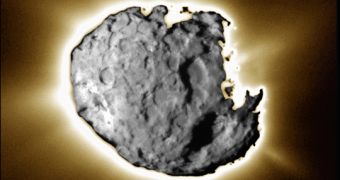Nine years ago, scientists launched a space probe in order to collect material from a comet formed at the far edges of our solar system. Surprisingly, they found out that the comet was comprised of particles similar to those forged in the proximity of the sun.
The Stardust probe had been launched from Cape Canaveral in order to meet with the Comet Wild 2 (pronounced "Vilt 2"), gather sample material from it and bring it back home for studies. While "dissecting" the material, researchers were sure to stumble upon the expected interstellar particles from the farthest outposts of our system. The recent discovery shows that the sample collected by Stardust during its seven-year cruise that took it halfway towards Jupiter is, in fact, the same material as the one that formed near the sun. Michael Zolensky from NASA, who studies cosmic dust and grains at the Johnson Space Center in Houston was puzzled: "We still think comets formed far from the sun, but the material that goes into comets didn't."
Tomoki Nakamura and his team from Kyushu University in Japan reported this week in Science magazine that they had uncovered chondrules (small pieces of molten mineral commonly found in meteorites) in the comet sample. This means that the particles from the inner solar system were somehow jetted to those nether regions before the solidification process of the system's bodies occurred. "This definitely kills one idea – that comets are formed of just interstellar material. That theory is just dead," said Zolensky in an interview for Discovery News.
Noriko Kita and his colleagues from the University of Wisconsin studied the small grains under a unique ion microscope. The largest of them can get to sizes of 1/1.000 of an inch (1/6.400 of one centimeter). They discovered that the oxygen isotope ratios were similar to those of materials in asteroids, meteorites or the sun. The studied chrondules are based on silicates, just like Earth's rocks, and they form at temperatures of 1,500 to 1,800 degrees Celsius (2730 to 3270 Fahrenheit). But these particles melted and cooled very fast, skipping crystallization.
Theories surrounding the event imply the young solar system was more like a blender. Particularly, one of them suggests the existence of two powerful interactive magnetic fields generated by the infant sun and the disk of dust and gas which created the rest of the system's bodies. Although it formed and evolved in the freezing cold of the Kuiper Belt, around 10% of the comet Wild 2's body is comprised of particles formed in the hot dust and gas cloud surrounding the infant sun. Robert Pepin, a physicist from the University of Minnesota, claims that "The particles probably came from the first million years – or even less – of the solar system's existence."
Referring to the solar system formation, Kita admitted: "We do not know the exact process yet. This observation motivates us to figure out the real condition of the early solar system." Zolensky would like to get his hands on samples collected from another comet, in order to prove that the recent findings are not a singular case. "We thought this was going to be a mission about what you'd find in the outer solar system but it turns out it's a mission about what's in the entire solar system. It makes it much more complicated, but it's more exciting," he added.

 14 DAY TRIAL //
14 DAY TRIAL //